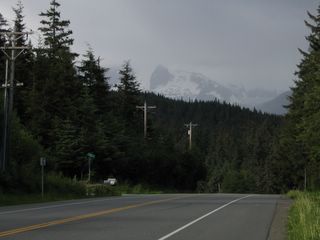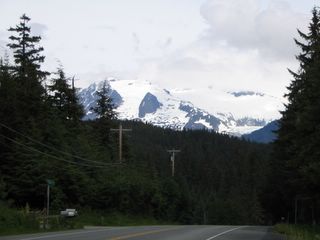Through a Glass, Brightly
These [small islands] the eye easily takes in and revels in their beauty with ever fresh delight. ~ John Muir |
I have been snapping many photographs since my arrival in Juneau two weeks ago, downloading on average twenty-four a day from my digital camera. When I look at a lush scene crowned by a grayish-purple peak cooled by a cap of fresh snow, I see it in a frame on my wall. I'm in the wilderness, yet my technique of observation is urbane. My eye revels in their pixelated beauty.
I grew up on the border of suburban Maryland and Washington, D.C. My schoolmates and I would joke about the tourists, cameras at the ready, who seemed to desire the visual preservation of the moment over the actual multi-sensory experience. I am repulsed by the thought that I may act like a tourist. To me the tourist is an individual who passes through a scene without engaging the setting.
My parents taught me to want to assume the identity of a local when visiting a new place. While adopting a new accent may not be possible or even considered appropriate by the local populace, making an effort to adopt local outlooks, at least temporarily, allows the tourist the opportonity to experience the flavor of the visited community. Perspective, therefore, can be achieved through discourse as well as the camera.
Face-to-face interaction enriches the tourist act, which is the modernist pursuit of making familiar that which is strange, by establishing a two-way exchange thereby encouraging mutual understanding; observation "through a glass, darkly," only leads to partial understanding (1 Cor. 13:12). Yet how does the adventurous tourist communicate with nature? The language barrier seems insurmountable. I must resort to my camera!
Indeed my camera has documented Nature's discourse. Every few days I have stopped at the same spot along Mendenhall Loop Road to take two photographs--one westward, the other eastward. Alone they present pretty scenes: glacier, spruce, ocean, mist, fog, sky, cloud. Yet read in series, they tell a story: Juneau has been breathing--rain; bright day; mist rises out of the forests; clouds form over the mountains; rain. In and out within a closed system. That nature is alive is not news; the most urbane scene presents critters who creep and crawl. That my environment breathes with one lung shakes me awake. I rub my eyes clear of their scales.
*John Muir, Travels in Alaska, 1915, San Francisco: Sierra Club, 1988. 15.
 |  |
 |  |


0 Comments:
Post a Comment
<< Home